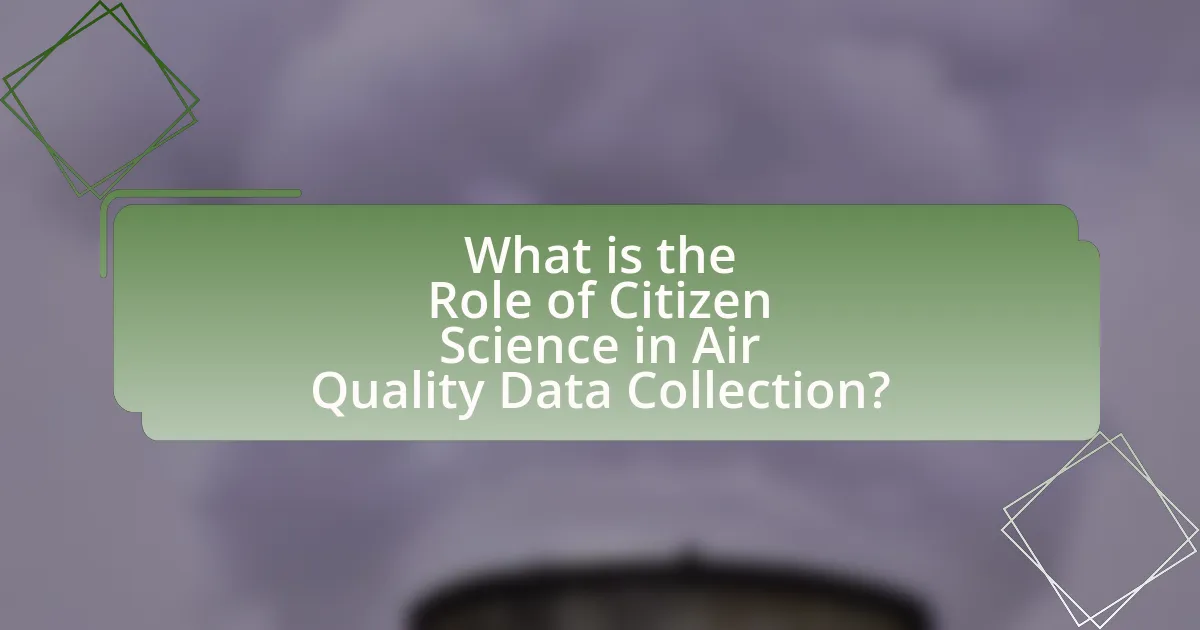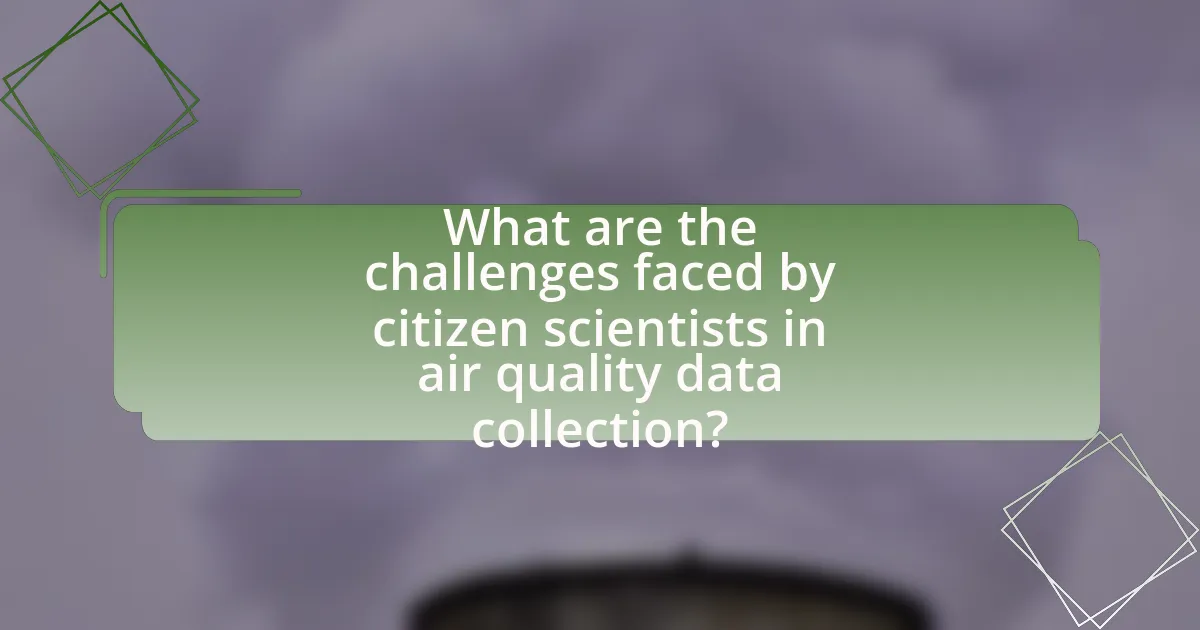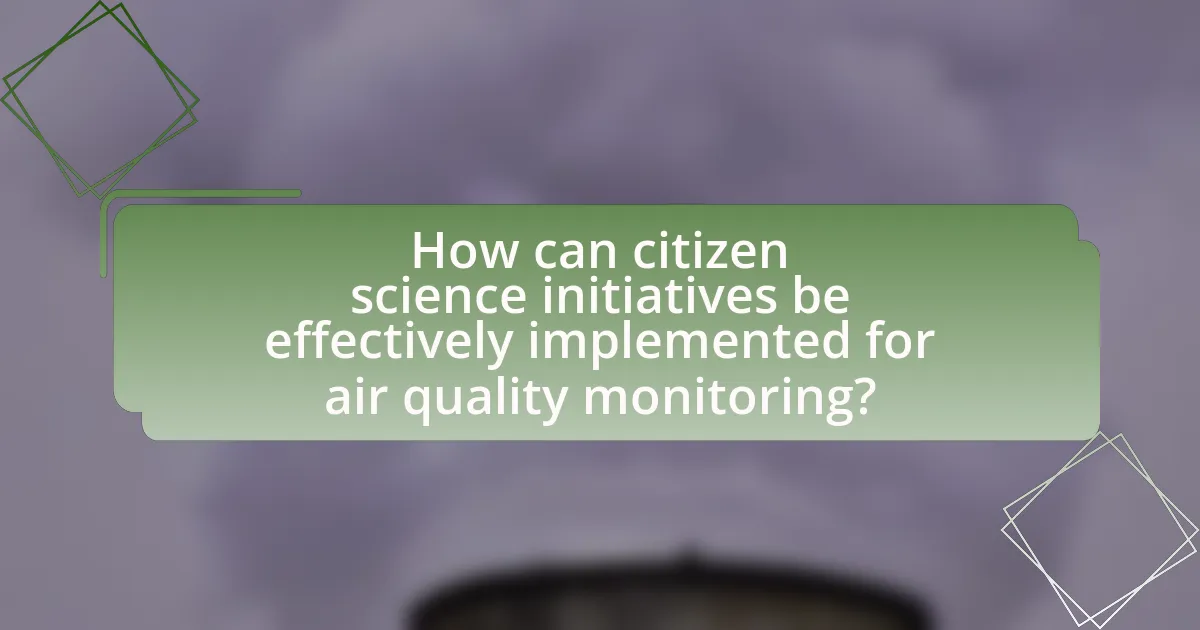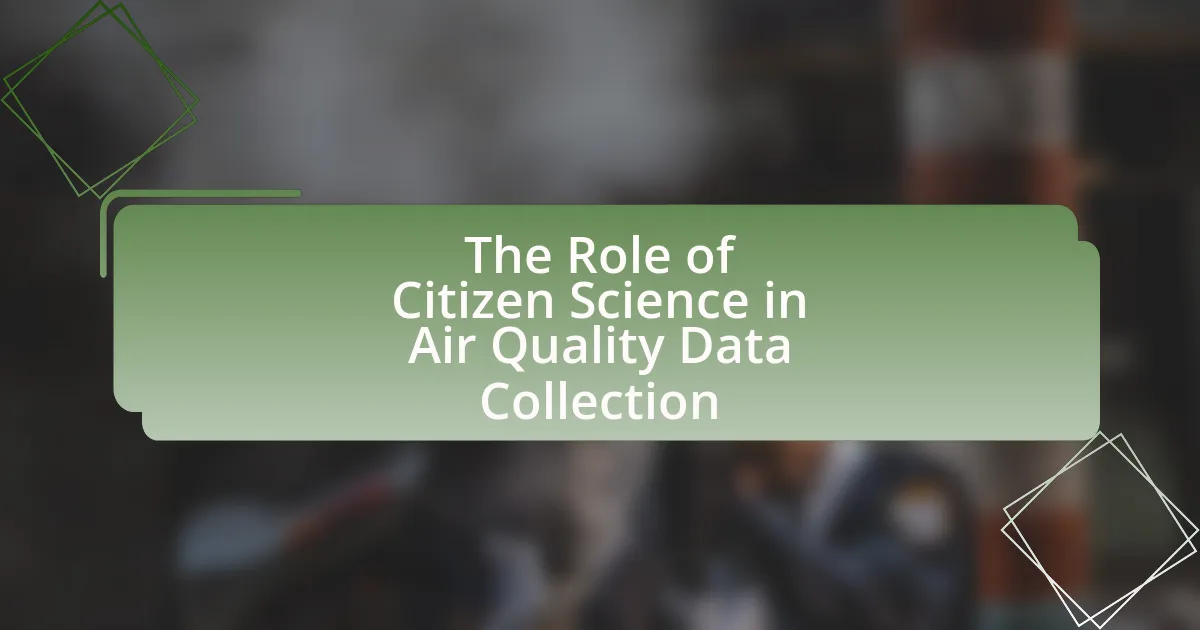Citizen science is increasingly recognized for its vital role in air quality data collection, allowing non-professionals to contribute to environmental monitoring. This article explores how citizen scientists enhance data availability and spatial coverage through low-cost sensors and community engagement, often producing data comparable in quality to professional monitoring networks. It examines the methods used for data collection, the reliability of citizen-generated data, and the impact of these initiatives on public awareness and policy decisions regarding air quality. Additionally, the article addresses the challenges faced by citizen scientists, including technical limitations and ethical considerations, while highlighting successful examples and best practices for effective air quality monitoring.
What is the Role of Citizen Science in Air Quality Data Collection?

Citizen science plays a crucial role in air quality data collection by enabling non-professionals to contribute to environmental monitoring efforts. This approach enhances data availability and spatial coverage, as citizens can deploy low-cost air quality sensors in diverse locations, often in areas where traditional monitoring stations are sparse. Studies have shown that data collected by citizen scientists can be comparable in quality to that from professional monitoring networks, thereby validating its use in research and policy-making. For instance, a study published in the journal “Environmental Science & Technology” demonstrated that citizen-collected data effectively captured local air pollution variations, supporting the integration of community-driven data into broader environmental assessments.
How does citizen science contribute to air quality monitoring?
Citizen science significantly contributes to air quality monitoring by enabling community members to collect and report data on air pollution levels. This grassroots involvement enhances the volume and spatial coverage of air quality data, which is often limited in traditional monitoring networks. For instance, projects like the Community Air Quality Monitoring Program have demonstrated that citizen-collected data can complement official measurements, providing a more comprehensive understanding of local air quality issues. Studies have shown that citizen science initiatives can lead to increased public awareness and engagement, ultimately influencing policy decisions related to air quality management.
What methods do citizen scientists use to collect air quality data?
Citizen scientists collect air quality data using methods such as low-cost sensors, mobile applications, and community-based monitoring programs. Low-cost sensors allow individuals to measure pollutants like particulate matter and volatile organic compounds in real-time, providing localized data. Mobile applications enable users to report air quality observations and access existing data, enhancing community engagement. Community-based monitoring programs often involve training volunteers to use specific equipment and protocols, ensuring data consistency and reliability. These methods collectively contribute to a broader understanding of air quality issues and empower communities to take action.
How reliable is the data collected by citizen scientists?
The data collected by citizen scientists can be reliable, particularly when proper protocols and training are implemented. Studies have shown that citizen science data can match the accuracy of professional data collection; for instance, research published in the journal “Environmental Science & Technology” by authors including Daniel J. Stow and others demonstrated that citizen-collected air quality data closely aligned with data from regulatory monitoring stations. This indicates that, under the right conditions, citizen scientists can provide valuable and trustworthy contributions to environmental monitoring efforts.
Why is citizen science important for air quality awareness?
Citizen science is important for air quality awareness because it empowers individuals to actively participate in monitoring and reporting air pollution levels. This grassroots involvement enhances data collection efforts, leading to more comprehensive and localized air quality information. Studies have shown that citizen science initiatives, such as the Community Air Quality Monitoring Program, can significantly increase the amount of data available for analysis, thereby improving public understanding of air quality issues and fostering community engagement in environmental advocacy.
What impact does citizen science have on public engagement with air quality issues?
Citizen science significantly enhances public engagement with air quality issues by actively involving community members in data collection and analysis. This participatory approach fosters a sense of ownership and responsibility towards local environmental conditions, leading to increased awareness and advocacy for cleaner air. Research indicates that citizen science projects, such as the Community Air Quality Monitoring initiative, have successfully mobilized residents to monitor air pollution levels, resulting in heightened public discourse and policy changes regarding air quality regulations. By empowering individuals with tools and knowledge, citizen science transforms passive observers into informed participants, thereby amplifying community voices in environmental decision-making.
How does citizen science influence policy decisions regarding air quality?
Citizen science significantly influences policy decisions regarding air quality by providing robust, community-generated data that enhances governmental understanding of local pollution levels. This data often reveals discrepancies between official measurements and actual conditions, prompting policymakers to reconsider regulations and enforcement strategies. For instance, studies like “The Role of Citizen Science in Air Quality Monitoring” published in Environmental Science & Policy demonstrate how citizen-collected data led to the implementation of stricter air quality standards in several regions. Such evidence illustrates that citizen science not only raises public awareness but also serves as a catalyst for informed policy changes aimed at improving air quality.
What are the challenges faced by citizen scientists in air quality data collection?

Citizen scientists face several challenges in air quality data collection, including limited access to reliable measurement tools, lack of training, and data validation issues. Access to high-quality sensors can be cost-prohibitive, leading to the use of less accurate devices that may not provide reliable data. Additionally, many citizen scientists lack formal training in data collection methodologies, which can result in inconsistent or erroneous data. Furthermore, the challenge of validating the data collected by non-professionals poses a significant barrier, as it is crucial to ensure that the information is accurate and comparable to data collected by established scientific methods. These challenges can hinder the effectiveness of citizen science initiatives in contributing valuable air quality data.
What technical challenges do citizen scientists encounter?
Citizen scientists encounter several technical challenges, including data accuracy, equipment limitations, and software usability. Data accuracy is often compromised due to the variability in measurement techniques and the lack of calibration of instruments used by non-professionals. Equipment limitations arise from the accessibility and affordability of high-quality sensors, which can lead to inconsistent data collection. Additionally, software usability issues can hinder data analysis and interpretation, as many citizen scientists may lack the technical expertise required to effectively use complex data processing tools. These challenges can significantly impact the reliability and effectiveness of citizen science initiatives in air quality data collection.
How can technology improve the data collection process for citizen scientists?
Technology can improve the data collection process for citizen scientists by providing accessible tools and platforms for real-time data gathering and analysis. Mobile applications enable users to easily record observations, such as air quality measurements, and upload them instantly to centralized databases. For instance, platforms like iNaturalist and Air Quality Egg facilitate the collection of environmental data by allowing citizen scientists to contribute their findings through user-friendly interfaces. Additionally, advancements in sensor technology have made it possible for individuals to use affordable air quality sensors that provide accurate readings, enhancing the reliability of the data collected. Studies have shown that data collected through these technologies can complement professional research, as evidenced by the collaboration between citizen scientists and institutions like NASA, which has utilized citizen-collected data to validate satellite observations.
What training or resources do citizen scientists need to overcome these challenges?
Citizen scientists need training in data collection methodologies and access to user-friendly tools to overcome challenges in air quality data collection. Training programs should focus on understanding air quality metrics, proper sampling techniques, and data analysis to ensure accuracy and reliability. Resources such as online courses, workshops, and instructional materials can provide essential knowledge. For instance, the U.S. Environmental Protection Agency offers resources that educate citizen scientists on air quality monitoring, which enhances their ability to contribute effectively to data collection efforts.
What ethical considerations arise in citizen science for air quality data collection?
Ethical considerations in citizen science for air quality data collection include issues of data privacy, informed consent, and the potential for data misuse. Participants must be informed about how their data will be used and the implications of their contributions, ensuring transparency and accountability. Additionally, the accuracy and reliability of the data collected can raise ethical concerns, as poor-quality data may lead to misguided public health decisions. Research indicates that ethical frameworks are essential for guiding citizen science projects, emphasizing the need for ethical training and guidelines to protect both participants and the integrity of the data collected.
How do privacy concerns affect data collection efforts?
Privacy concerns significantly hinder data collection efforts by limiting the types of data that can be gathered and the methods used to collect it. For instance, when individuals fear that their personal information may be misused or inadequately protected, they are less likely to participate in data collection initiatives, such as citizen science projects focused on air quality. This reluctance can lead to incomplete datasets, which ultimately compromises the quality and reliability of the research findings. According to a study published in the Journal of Environmental Management, 70% of participants expressed concerns about data privacy, which directly impacted their willingness to share information. Thus, privacy concerns create barriers that can reduce participation and the overall effectiveness of data collection efforts.
What measures can be taken to ensure ethical practices in citizen science?
To ensure ethical practices in citizen science, researchers must implement clear guidelines for participant consent and data usage. Establishing informed consent protocols ensures that participants understand their roles and the implications of their contributions. Additionally, providing training and resources helps participants collect data accurately and responsibly. Transparency in data management, including how data will be used and shared, fosters trust and accountability. Furthermore, adhering to ethical standards set by organizations such as the American Psychological Association can guide researchers in maintaining ethical integrity. These measures collectively promote ethical engagement and protect the rights of citizen scientists.
How can citizen science initiatives be effectively implemented for air quality monitoring?

Citizen science initiatives can be effectively implemented for air quality monitoring by engaging local communities in data collection through accessible technology and structured protocols. This approach empowers citizens to use low-cost air quality sensors, which have been shown to provide reliable data when calibrated correctly, as evidenced by studies such as those conducted by the Environmental Protection Agency, which highlight the effectiveness of community-collected data in complementing traditional monitoring methods. Additionally, providing training and resources ensures that participants understand the importance of accurate data collection, thereby enhancing the quality and reliability of the information gathered.
What strategies can enhance participation in citizen science projects?
To enhance participation in citizen science projects, strategies such as effective communication, community engagement, and providing accessible tools are essential. Effective communication involves clearly articulating the project’s goals and the impact of participants’ contributions, which can motivate involvement. Community engagement fosters a sense of ownership and relevance, encouraging local populations to participate actively. Providing accessible tools, such as user-friendly apps or platforms for data collection, simplifies participation and increases the likelihood of involvement. Research indicates that projects with strong community ties and clear communication see higher participation rates, as evidenced by studies like “The Role of Citizen Science in Environmental Monitoring” published in the journal Environmental Science & Policy, which highlights the importance of these strategies in successful citizen science initiatives.
How can community engagement be fostered in air quality initiatives?
Community engagement in air quality initiatives can be fostered through participatory approaches that involve citizens in data collection and decision-making processes. By utilizing citizen science, communities can actively monitor air quality using accessible tools and technologies, such as low-cost sensors, which empowers individuals to contribute valuable data. Research indicates that when citizens are involved in the scientific process, such as in the study “Citizen Science: Theory and Practice” by He et al. (2018), it enhances their understanding of air quality issues and promotes collective action. Furthermore, organizing workshops and educational programs can increase awareness and motivate community members to participate in air quality monitoring efforts, thereby strengthening community ties and fostering a sense of ownership over local environmental health.
What role do partnerships play in successful citizen science projects?
Partnerships are crucial for the success of citizen science projects as they enhance resource sharing, expertise, and community engagement. Collaborations between academic institutions, government agencies, and local communities facilitate access to scientific knowledge and technical support, which are essential for effective data collection and analysis. For instance, the collaboration between the University of California and local residents in the “Air Quality and Health” project demonstrated that partnerships can lead to more comprehensive data sets and increased public awareness about air quality issues. This synergy not only improves the quality of the research but also fosters a sense of ownership and responsibility among participants, ultimately leading to more impactful outcomes in addressing air quality concerns.
What are some successful examples of citizen science in air quality data collection?
Successful examples of citizen science in air quality data collection include the PurpleAir project and the Air Quality Egg initiative. The PurpleAir project utilizes low-cost air quality sensors deployed by community members to gather real-time data on particulate matter levels, which has been instrumental in identifying pollution hotspots and informing local air quality management. The Air Quality Egg initiative encourages individuals to build and deploy their own air quality monitoring devices, contributing to a global network that provides valuable data for research and policy-making. Both projects demonstrate the effectiveness of citizen involvement in enhancing air quality monitoring and fostering community engagement in environmental issues.
What lessons can be learned from these successful initiatives?
Successful initiatives in citizen science for air quality data collection demonstrate the importance of community engagement, data accuracy, and collaboration. Engaging local communities fosters a sense of ownership and responsibility, leading to increased participation and more comprehensive data collection. For instance, projects like the “Air Quality Egg” have shown that when citizens are involved in monitoring their environment, they are more likely to act on the findings, thereby enhancing public awareness and advocacy for cleaner air. Additionally, ensuring data accuracy through standardized protocols and training for volunteers is crucial, as evidenced by the “PurpleAir” network, which provides reliable real-time air quality data. Collaboration between scientists, local governments, and citizens enhances the effectiveness of these initiatives, as seen in the “Breathe London” project, which successfully integrated citizen-collected data with official monitoring systems to inform policy decisions.
How can these examples be replicated in other communities?
Citizen science initiatives for air quality data collection can be replicated in other communities by establishing local partnerships, utilizing accessible technology, and engaging community members in the data collection process. Communities can form collaborations with local universities, environmental organizations, and government agencies to share resources and expertise, as seen in successful projects like the Community Air Quality Monitoring Program in San Francisco. Additionally, employing low-cost air quality sensors and mobile applications allows residents to easily participate in data collection, similar to the use of the Air Quality Egg project, which empowers individuals to monitor air quality in their neighborhoods. Engaging community members through workshops and educational campaigns fosters a sense of ownership and responsibility, which has proven effective in initiatives like the PurpleAir network, where local volunteers actively contribute to air quality monitoring efforts.
What best practices should citizen scientists follow for effective air quality data collection?
Citizen scientists should follow standardized protocols for effective air quality data collection. This includes using calibrated instruments to ensure accuracy, collecting data at consistent times and locations to maintain comparability, and documenting environmental conditions such as temperature and humidity during measurements. Additionally, citizen scientists should participate in training sessions to understand the importance of data quality and the specific methodologies used in air quality monitoring. Research indicates that adherence to these practices significantly enhances the reliability of data collected, as evidenced by studies showing that standardized methods yield results that align closely with professional monitoring networks.
How can citizen scientists ensure the accuracy of their data?
Citizen scientists can ensure the accuracy of their data by following standardized protocols and utilizing calibrated equipment. Adhering to established guidelines, such as those provided by organizations like the U.S. Environmental Protection Agency, helps maintain consistency in data collection methods. Additionally, using properly calibrated instruments, such as air quality sensors that have been verified against reference standards, enhances the reliability of the measurements taken. Studies have shown that when citizen scientists are trained in these protocols, the data collected can be comparable to that of professional scientists, thereby validating the accuracy of their contributions to air quality monitoring.
What tools and resources are recommended for citizen scientists in air quality monitoring?
Citizen scientists in air quality monitoring are recommended to use low-cost air quality sensors, mobile applications, and online platforms for data collection and sharing. Tools such as the PurpleAir sensor provide real-time particulate matter data, while apps like AirVisual and Breezometer offer air quality index readings and health recommendations. Online platforms like AirCasting and the Citizen Science Air Quality project facilitate data sharing and collaboration among citizen scientists. These resources enable individuals to contribute valuable data to larger air quality studies, enhancing community awareness and engagement in environmental issues.

Leave a Reply